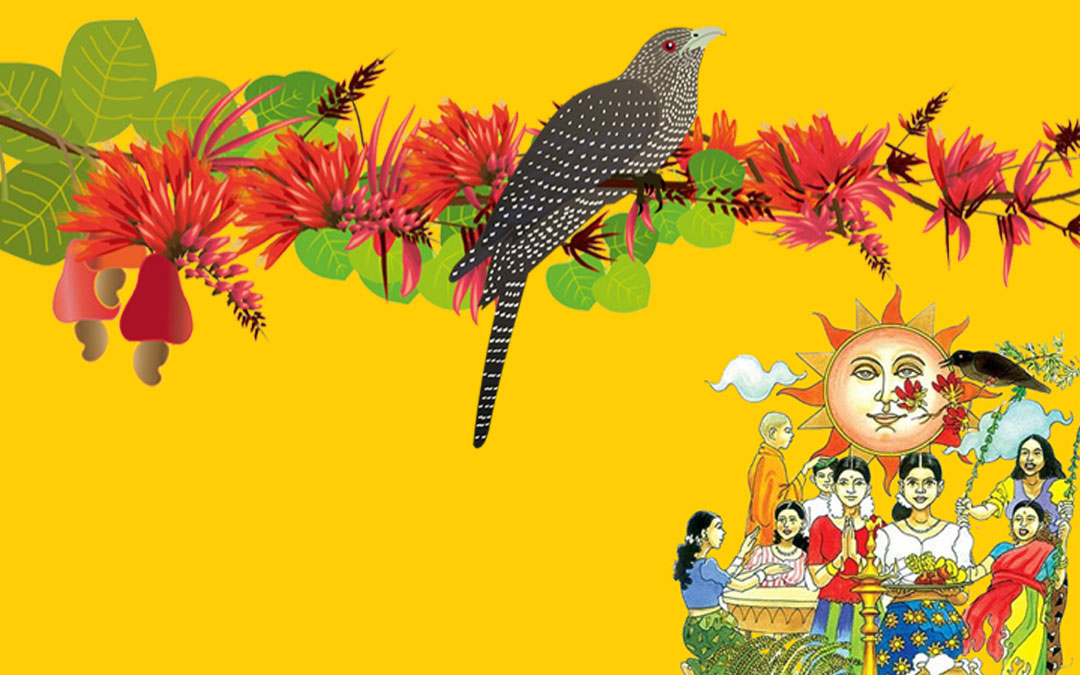The call of the Koha, a type of cuckoo bird, only occurs around a certain time of the year, typically April. As this call floods Sri Lanka, the whole country starts to burst with energy because the bird calls signal that one of the most important celebrations — the dawn of the new year — is here. Store windows fill with large discount signs and supermarkets overflow with Avurudu kama, a New Year delicacy, propped up on dried coconut leaves. The clay roofed houses are buried in color as small, temporary stalls are set up on the streets to sell fireworks. The small kades — shops — sell more betel leaves, which are usually sold in bundles of 40 leaves. It is perhaps the noisiest, most vibrant time of the year. Families around the country make sure that their homes are extra clean, even painted anew, while they prepare special New Year treats and buy clothes and presents.
The dawn of the Solar New Year is commemorated when the constellations switch from Pisces to Aries, usually between April 12 and 14. The exact time changes every year; on some occasions we have waited till early morning for the new year to dawn. Astrologers study the constellations and determine the auspicious times for traditional rituals. Every year, there is a lucky color to wear, celebration typically include a traditional lamp that most households own. The traditional bronze lamps are generally 6 feet tall, made of a long circular pillar with three layers of sunburst-shaped plates, each with six to eight rounded triangle tips, into which oil is poured. At the auspicious time, facing the auspicious direction, my whole family lights the lamp. The dawn is often accompanied by the sound of firecrackers bursting through the air.
Then it is time to prepare the traditional kiribath, a milk rice dish. Although we use gas and electric stoves now, traditionally this has meant setting up a fire on the floor with a milk-filled clay pot. Some families still use this method. We consider it lucky if the milk froths and spills over, if the overflowing white bubbles stream down the sides of the brown clay pot like a waterfall. The milk is then used to make kiribath. Once the kiribath has been prepared my family sits down to enjoy all the food that we usually only make once a year. The head of the family feeds each member kiribath starting from the oldest to the youngest, which in my family happens to be our dogs.
The next auspicious time is for the exchange of greetings and money within my family as well as with our neighbors. Younger family members gift the elders a sheath of betel leaves to show respect. Elders give them money in return. Afterwards, we visit our extended family and neighbours to exchange even more presents and sweets. Along the way, we also visit temples or other places of religious worship.
Afterwards, we gather to play traditional games. These include kanna mutti, in which participants are blindfolded as they attempt to break clay pots hanging from a string with a baton, and kotta pura, in which two participants balance themselves on a horizontal log lifted a foot or so above the ground and attempt to immobilize the other participant by hitting them with a pillow. As children, for the school’s new year events, we would often dress up in the traditional clothing — for women, a cropped-jacket and a long wrap-around skirt and, for men, a shirt and a sarong.
Originally published by ‘The Gazelle’, an NYUAD student publication on 05th March, 2017. https://www.thegazelle.org/issue/108/avuduru

